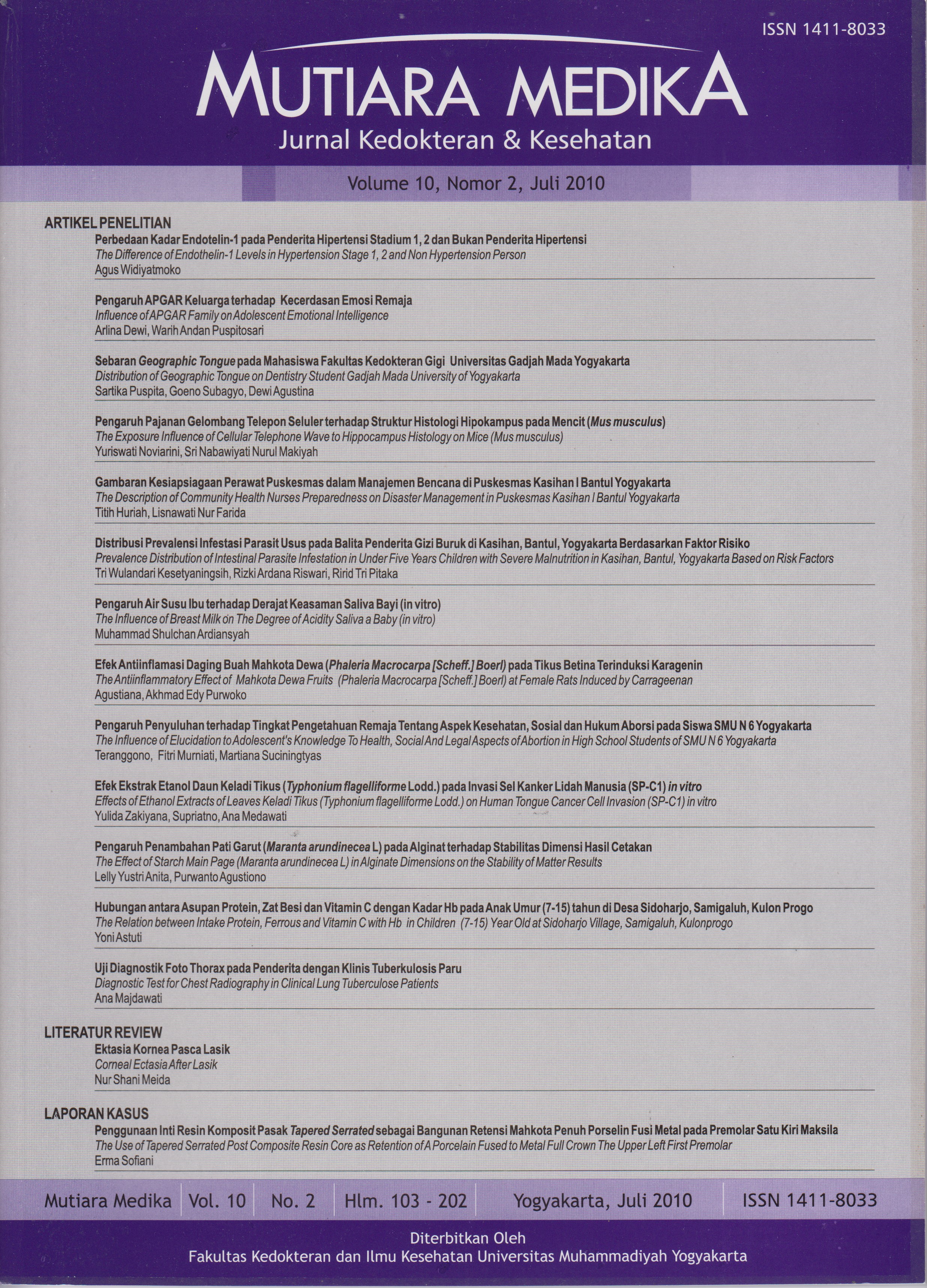Sebaran Geographic Tongue pada Mahasiswa Fakultas Kedokteran Gigi Universitas Gadjah Mada Yogyakarta
DOI:
https://doi.org/10.18196/mmjkk.v10i2.1572Keywords:
geographic tongue, sebaran, jenis kelamin, tahun akademik, kebersihan mulut, distribution, gender, academic year, oral hygieneAbstract
Tongue is barometer of health and sytemic condition. Geographic tongue hasn ’t been dangerous and asymptomatic lesion in papilla of the tongue. The aim of this study is to know geographic tongue distribution on dentistry student of Gadjah Mada University of Yogyakarta. The study was descriptive research. Limitation of the population are student of the Faculty of Dentistry, Gadjah Mada University in the academic year 1999-2003. The samples were 362 people. The method were clinical examination of dorsum of the tongue and oral hygiene index (OHI). The result were analyzed with chi-square test. The result of this study are 8 (2,21%) from 362 samples are geographic tongue, 5 male (6,25%) and 3 female (1,06%). Eight cases of geographic tongue are distributed in the each academic year, they are 3 cases (4,17%) on academic year of1999, 1 case (1,32%) on academic year of2000, 2 cases (2,82%) on academic year of2001, 1 case (1,43%) on academic year of2002 and 1 case (1,37%) on academic year 2003. The conclution is that gender is significant but oral hygiene and academic year aren ’t significant in case of geographic tongue. Distribution of geographic tongue on dentistry student of Gadjah Mada University have variation.
Lidah adalah barometer kesehatan yang mencerminkan kondisi sistemik. Geographic tongue adalah kondisi yang tidak membahayakan biasanya merupakan kondisi asimtomatik dengan etiologi tidak diketahui yang menyangkut epitel lidah. Tujuan penelitian ini adalah untuk mengetahui gambaran sebaran geographic tongue pada mahasiswa Fakultas Kedokteran Gigi Universitas Gadjah Mada Yogyakarta. Jenis penelitian adalah penelitian deskriptif. Batasan populasi adalah mahasiswa Fakultas Kedokteran Gigi Universitas Gadjah Mada Yogyakarta angkatan 1999 - 2003. Jumlah sampel berjumlah 362. Cara penelitian yaitu dengan melakukan pemeriksaan klinis pada permukaan dorsal lidah dan status kebersihan mulut (oral hygiene index/OHI). Hasil penelitian dianalisis dengan uji chi-square. Hasil penelitian menunjukkan dari 362 mahasiswa yang diperiksa ditemukan 8 kasus (2,21%) geographic tongue yang terdiri dari 5 pria (6,25%) dan 3 wanita (1,06%). Delapan penderita geographic tongue tersebar di tiap tahun angkatan akademik, terdiri dari 3 orang (4,17%) angkatan 1999, 1 orang (1,32%) angkatan 2000, 2 orang (2,82%) angkatan 2001, 1 orang (1,43%) angkatan 2002 dan 1 orang (1,37%) angkatan 2003. Semua penderita geographic tongue memilki status kebersihan mulut baik. Disimpulkan bahwa sebaran geographic tongue di Fakultas Kedokteran Gigi Universitas Gadjah Mada bervariasi, jenis kelamin berpengaruh terhadap kejadian geographic tongue, sedangkan tahun angkatan akademik dan status kebersihan mulut tidak berpengaruh terhadap kejadian geographic tongue.
References
Situmorang, N. 2001, Penyakit Gigi dan Mulut serta Pengaruhnya terhadap Kualitas Hidup, Dentika Dental Journal, 6 : 184 - 188.
Pamardiningsih, Y. 1996, Pengaruh Pengetahuan, Perilaku dan Persepsi Kesehatan Gigi dan Mulut terhadap Status Kesehatan Gigi dan Mulut pada Masyarakat Pedesaan dan Perkotaan di Yogyakarta, Ceril V, ed. Khusus, lustrum VIII FKG UGM, Yogyakarta, h.541-554.
Kleinman, D.V., Swango, P.A. & Niessen, L.C. 1991. Epidemiologic Studies and Oral Mucosa Conditions Methodologic Issues, Community Dental Oral Epidemiol., 19:129-140.
Bouquot, J.E. & Gundlach, K.H. 1986, Odd Tongue: The Prevelence of Common Tongue Lesions in 23.616 White Americans Over 35 Years of Age, Quintenssence International, 17(11):719-730.
Beck, J.D. & Watkins, C. 1992, Epidemiology of Non Dental Oral Disease in The Elderly. Dental Clinic of The North America. W.B. Saunders Co., America, h. 461 - 467.
Kay L.W. & Haskell R., 1971, Wolf Medical Athlases a Colour Athlas of Orofacial Diseases 4th ed., Year Book Medical Publisher Inc., England, h.188.
Pindborg, J.J. 1994, Atlas Penyakit Mukosa Mulut (terj.), 4th ed., Binarupa Aksara. Jakarta. h. 216, 222.
Kelsch, R. 2003, www. eMedicine- Geographic Tongue Article by Robert Kelsch, DMD.htm.
Cawson, R.A, Binnie, W.H. & Everson, J.W. 1994, Colour Atlas of Oral Disease Clinical and Pathologic Correlation, 2nd ed., Wolfe, London, h.1.14, 12.22.
Axell, T., Zain, R.B, Siwamogstham, P., Tantiniran, D. & Thampipit, J. 1990, Prevalence of Oral Soft Tissue Lessions in Out - Patients at Two Malaysian and Thai Dental Schools, Community Dental Oral Epidemiol., 18 : 95 - 99.
Mitchell, D.F., Standish, S.M. & Fast, T.B. 1969, Oral Diagnosis Oral Medicine, Lea & Febiger. Philadelphia. h. 108, 109, 300.
Leeson, C.R., Leeson, T.S. & Paparo, A.A. 1995, Buku Ajar Histologi (terj), EGC. Jakarta. h. 327 - 331.
Downloads
Published
Issue
Section
License
Copyright
Authors retain copyright and grant Mutiara Medika: Jurnal Kedokteran dan Kesehatan (MMJKK) the right of first publication with the work simultaneously licensed under an Attribution 4.0 International (CC BY 4.0) that allows others to remix, adapt and build upon the work with an acknowledgment of the work's authorship and of the initial publication in Mutiara Medika: Jurnal Kedokteran dan Kesehatan (MMJKK).
Authors are permitted to copy and redistribute the journal's published version of the work (e.g., post it to an institutional repository or publish it in a book), with an acknowledgment of its initial publication in Mutiara Medika: Jurnal Kedokteran dan Kesehatan (MMJKK).
License
Articles published in the Mutiara Medika: Jurnal Kedokteran dan Kesehatan (MMJKK) are licensed under an Attribution 4.0 International (CC BY 4.0) license. You are free to:
- Share — copy and redistribute the material in any medium or format.
- Adapt — remix, transform, and build upon the material for any purpose, even commercially.
This license is acceptable for Free Cultural Works. The licensor cannot revoke these freedoms as long as you follow the license terms. Under the following terms:
Attribution — You must give appropriate credit, provide a link to the license, and indicate if changes were made. You may do so in any reasonable manner, but not in any way that suggests the licensor endorses you or your use.
- No additional restrictions — You may not apply legal terms or technological measures that legally restrict others from doing anything the license permits.



